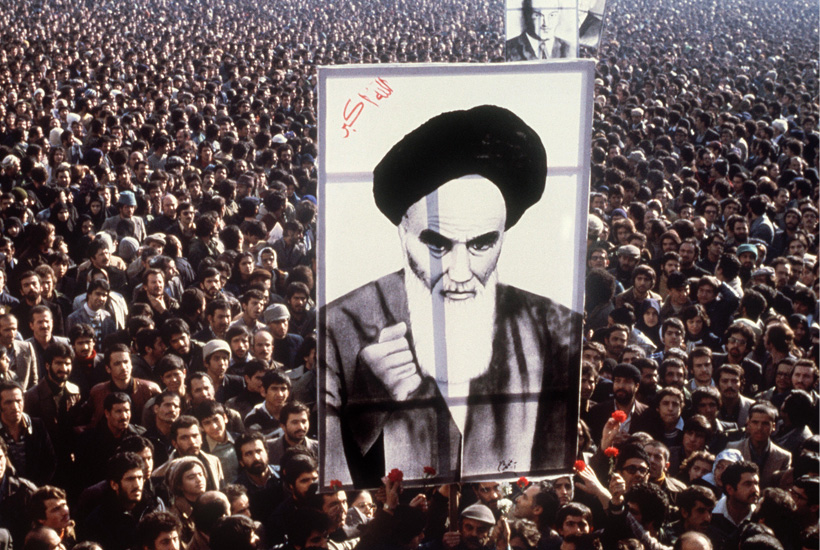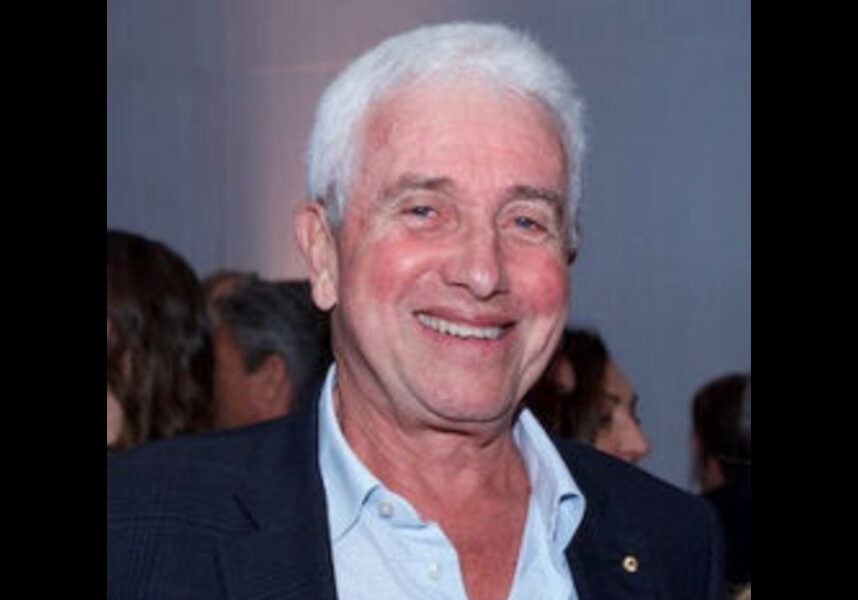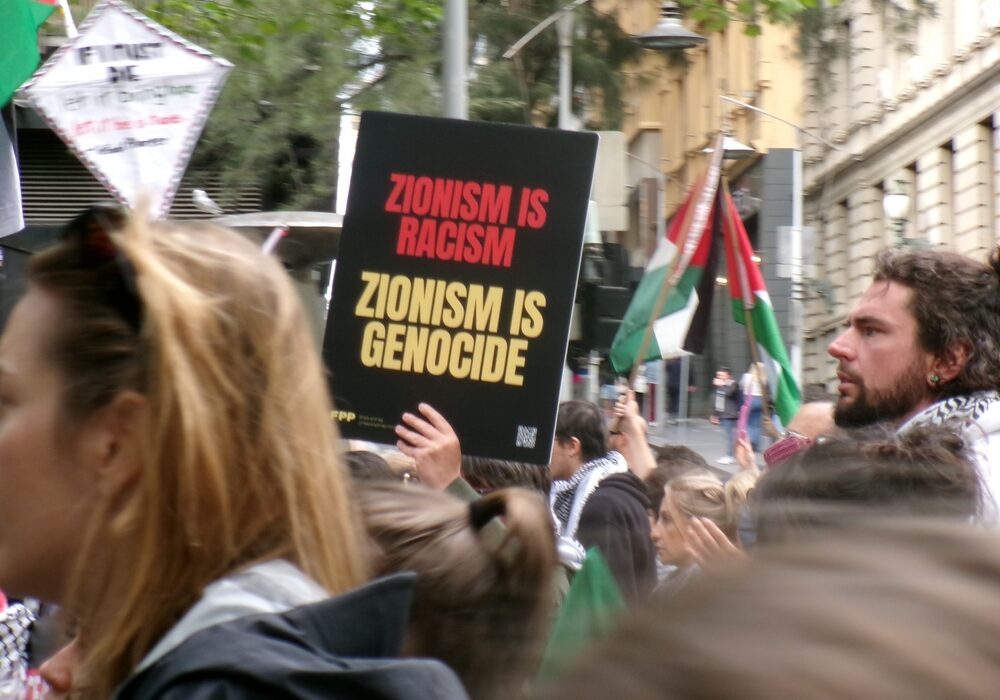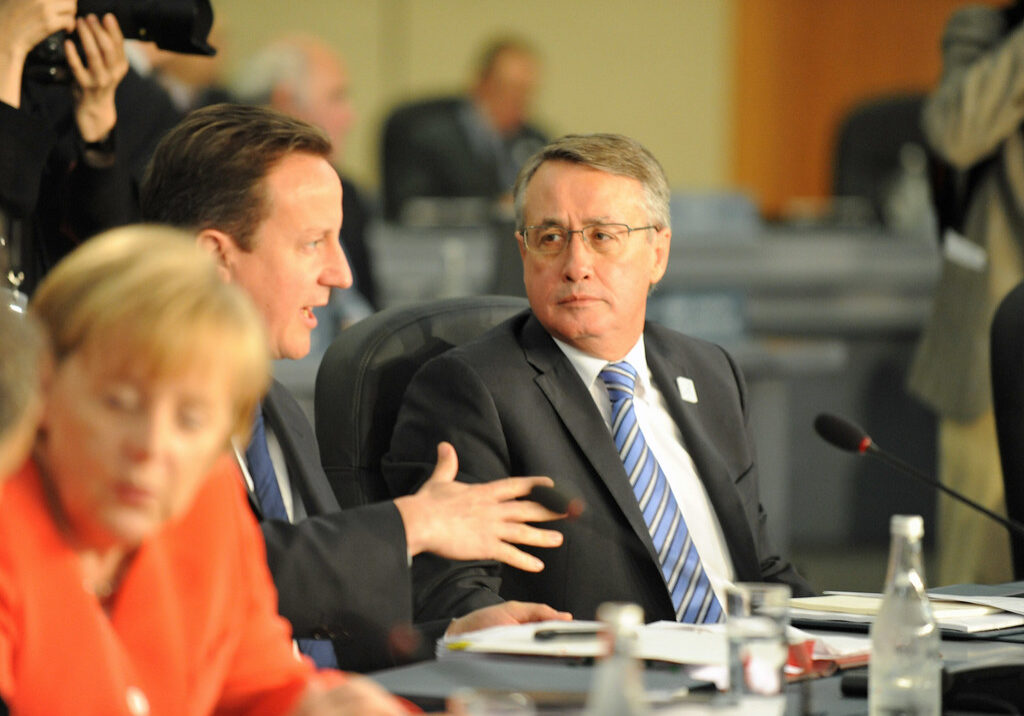Australia/Israel Review
Essay: Washington’s Iran Lobby
Jul 29, 2015 | Sohrab Ahmari

Sohrab Ahmari
Iran’s Ayatollah Khomeini bangs his fists on the table. “Gentlemen, gentlemen!” he says. “If we do nothing else this week, we must conceive at least one terrorist act that will show all the world that the United States, the Great Satan, is but a paper tiger!” He is chairing a gathering of the infamous, among them Yasser Arafat, Muammar Gaddafi, and Mikhail Gorbachev. In the background, the man serving tea to the assemblage suddenly doffs his garb to reveal he is Frank Drebin of Police Squad. Drebin then delivers a well-deserved whupping to the whole lot of international thugs.
The opening of The Naked Gun, the wild comedy film from 1988, is a peerless artefact of the Reagan decade – a clarifying example of America’s profound hostility toward the Iranian regime and its leader. It hit screens only seven years after the advent of Ronald Reagan’s presidency led the regime to release the 52 American hostages it had held for 444 days beginning on November 4, 1979. In the years following, Khomeinists would continue to burn the American flag on the streets of Teheran in hateful rituals broadcast worldwide. They would found the Lebanese terror group Hezbollah, responsible for the 1983 Beirut barracks bombing, the single deadliest attack on US Marines since World War II.
Flash-forward 27 years. The Iranian regime is still holding American hostages. These include the Washington Post‘s Teheran correspondent, Jason Rezaian, and Amir Hekmati, an Iranian-American US Marine sentenced to death in 2012 on bogus spying charges and still languishing in the mullahs’ hellish prisons. American flags are burned, and cries of “Death to America!” still ring out at Friday prayers across Iran. The Teheran regime continues to arm and fund Hezbollah, and Iranian forces and proxies now encircle the Arab lands. And the mullahs have in the intervening years raced to develop nuclear weapons, their centrifuges churning in defiance of five United Nations Security Council resolutions.
Now cut to the Oval Office. It’s Christmas 2014, and Barack Obama is sitting down for one of his periodic interviews with the liberal press. “You need to understand what their legitimate needs and concerns are,” the president tells National Public Radio, speaking of the Iranian regime. Washington should distinguish those legitimate needs from Teheran’s “adventurism,” support for Hezbollah, and threats against Israel. If the Iranians could separate the realist wheat from the Khomeinist chaff, the president says, the Islamic Republic “could be a very successful regional power.”
This was an astonishing moment: Who could have imagined, even two or three years earlier, the president of United States in effect wishing the mullahs well in their quest for regional hegemony? And yet here we were.
The metamorphosis of Iran, in elite American opinion, from terrorist state into US partner is a long-brewing triumph for a certain set of ideas about the Islamic Republic and its relation to the nation it has called the “Great Satan” since its birth. Over time, the argument has been advanced by journalists, academics, Washington lobbies and government officials. Its basic purpose has always been to sell the Iranian regime as moderate, amenable to reason, even decent and democratic, relative to its neighbours. The various arms of this campaign didn’t always work in concert. Frequently, it was advanced by well-intentioned but credulous journalists. The rebranding campaign was not a dark conspiracy; it was, for the most part, carried out openly.
Nevertheless, Iran’s apologists have now scored an unprecedented coup: making the US friendly toward a regime whose motto is “Death to America”.
A New York Times op-ed by Princeton scholar Richard Falk, published only days after Khomeini seized power in Iran in February 1979, can now be seen as the ur-text of American apologetics for the Islamic Republic. “In recent months,” Falk wrote,
before his triumphal return to Teheran, the ayatollah gave numerous assurances to non-Moslem communities in Iran. He told Jewish-community leaders that it would be a tragedy if many of the 80,000 Jews left the country. Of course, this view is qualified by his hostility to Israel because of its support for the Shah and its failure to resolve the Palestinian question. He has also indicated that the non-religious left will be permitted to express its views in an Islamic republic and to participate in its political life. . . To suppose that Ayatollah Khomeini is dissembling seems almost beyond belief. . . What is also encouraging is that his entourage of supporters is uniformly composed of moderate, progressive individuals.
Falk concluded: “Iran may yet provide us with a desperately needed model of humane governance for a third-world country.” [Ed. Note: The same Prof. Falk would later earn notoriety for his extreme pro-Hamas slant and reproduction of antisemitic material as UN Special Rapporteur for the Palestinian Territories.]
Seen in light of the revolutionary bloodletting and repression that followed Khomeini’s rise, the Falk op-ed is a case study in credulous reporting and mushy thinking. But we can see its contours at work today, in the way President Obama is trying to sell his nuclear deal with Iran. Consider each of these rhetorical strategies:
- the insistence that the Khomeinist core includes reformers and moderates, who have genuine ideological rather than merely tactical disagreements with so-called hard-liners (Khomeini’s “uniformly” progressive entourage);
- a willingness to take Iranian officials at their word, and a corresponding refusal to grant the same benefit of the doubt to their opponents and victims (Khomeini’s assurances to Iran’s Jews and leftists);
- the notion that behind the Khomeinists’ eliminationist slogans are grievances and legitimate aspirations, which the West would be wise to accommodate (Khomeini objected to Israel’s “support for the Shah” and failure to “resolve the Palestinian question”); and
- the attempt to persuade Americans that the Islamic Republic, for all its flaws, represents a progressive step forward for the region (“model of humane governance”).
The Obama Administration has put forth variations of all these arguments over the past six years. The President has recently said that the regime only pursues antisemitic policies “at the margins.” Various administration figures have uncritically repeated the regime line that Supreme Leader Ayatollah Khamenei has issued a fatwa prohibiting nuclear weapons. The White House is fond of publicly pillorying America’s Arab and Israeli allies, and domestic opponents of his nuclear diplomacy, as hard-liners who unwittingly aid hard-liners in Teheran. And US Secretary of State John Kerry echoed the regional-beacon argument when he said in February 2013 that “Iran is a country with a government that was elected.”
Even in the 1980s, when the mere mention of the word Iran was enough to spark rage in the hearts of most Americans, the regime attempted something like a rebranding. Desperate for more sophisticated arms than it possessed amid the grinding Iran-Iraq War, Teheran telegraphed a willingness to covertly engage the Reagan Administration. There are moderates among the new revolutionary elite, the Reagan White House was told, and while an outright reconciliation was out of the question, Washington and Teheran could perhaps reach an understanding on mutual areas of interest.
The pitch worked, and the Reagan team resolved to sell the mullahs antitank missiles, first via Israeli intermediaries and later directly. The Iranian moderates never materialised, however, and the Reagan team soon concluded that it was doing little more than paying ransom in arms to a hostage-taking regime.
Even so, aware of Iran’s strategic centrality and its place as one of the key exporters of the substance that made the world run, post-Reagan US administrations of both parties continued to seek reconciliation with Teheran over the next two decades, often covertly.
The 9/11 attacks opened a window of opportunity for those seeking rapprochement between the United States and Iran. The terrorists who brought down the Twin Towers were Arabs, and they drew ideological inspiration from the wellspring of Sunni Islamism. America was bound to lash out at the Sunni sphere. Where did the Islamic Republic – characterised by its adherence to Shi’ite Islam – stand in the post-9/11 world? Would it be seen as an ally in the fight against Sunni extremism, or would the new George W. Bush White House lump Teheran in with other state sponsors of terrorism that the Administration had vowed to punish? Terrorism, Bush Administration principals knew, had been a central plank of Iranian statecraft, and it was the Khomeinists who had actually built the first modern, revolutionary Islamist state – something (pre-ISIS) Sunni Islamists could only dream of.
But hold on, urged a growing media and academic chorus. More than half of university students in Iran are women. The country has a vibrant film industry; a glorious history predating Islam by at least a millennium; a beautiful literary culture that emphasises love of wine, dance, and idyllic pastures; and a tradition of secular politics, albeit repressed. And behold, on 9/11, Iranians poured into the streets, lighting candles to mourn the victims.
All of which was true. Even so, there was a great deal of misdirection in this line of argument. For starters, the glories of Persian civilisation, liberal and secular instincts, the courage of Iranian women seeking equality, latent pro-American sentiments – all were things the Khomeinist regime had attempted to flog, jail, and censor out of the Iranian soul over the previous two decades. That an anti-American regime tolerated a day of mourning when it feared Washington’s wrath did little credit to the regime. This same regime, it bears reminding, didn’t mask, even temporarily, its countless anti-American displays.
The image of Iran as a counter-terrorism partner was supplemented with a mythology of grievance and victimisation that, its proponents hoped, would soften those inconvenient historical tidbits Americans clung to, not least the 1979 hostage crisis. The mythology came in the form of All the Shah’s Men, a 2003 history of the coup that toppled Prime Minister Mohammad Mossadegh, after he tried to nationalise Iran’s oil.
The book averred that in toppling Iran’s “democratically elected” leader Mossadegh in 1953, the CIA and MI6 had invited the Islamist fury that would blow back against the West in 1979 and again on 9/11. The author, former New York Times correspondent Stephen Kinzer, didn’t read Persian, and he relied heavily on the memoirs of Kermit Roosevelt, a one-time CIA spook with a penchant for self-aggrandisement who was eager to tout his own outsize role in shaping Cold War events, including the anti-Mossadegh coup.
In constructing this myth of American perfidy in Iran, Kinzer played down Mossadegh’s own demagogic tendencies (by the time he was toppled, the Premier had dissolved the Senate and was ruling by decree). The author pooh-poohed the real risk that Mossadegh’s nationalist movement could soon have been swallowed by the Tudeh, the Soviet-aligned Iranian Communist Party (nationalist rallies drew thousands of supporters, while Tudeh rallies drew up to 100,000). And Kinzer neglected the fact that the balance of social forces in Iran had already tipped against Mossadegh when he was toppled in the coup.
Crucially, Mossadegh had drawn the enmity of the clerical class – the same Islamists, in other words, who would go on to lead the 1979 revolution. Thus, even assuming the CIA played the pivotal role Kinzer attributed to it (it didn’t), the mullahs lacked the moral and historical standing to claim that they remained outraged at Mossadegh’s ouster. To this day, the Teheran regime marginalises the secular Mossadegh’s legacy at home even as it uses the coup to grievance-monger abroad.
Still, Kinzer’s Mossadegh narrative was irresistible. No criticism of the Iranian regime could be uttered without some well-meaning journalist or think-tanker retorting that, “yes, the mullahs do some awful things, but you know, America toppled Iran’s democratically elected prime minister.”
Meanwhile, credulous journalists and think-tankers stressed once more the existence of regime-reformers and moderates, and the importance of cultivating these, lest the hard-liners take over.
They pointed to the re-election, in summer 2001, of a mild-mannered, smiling cleric named Mohammad Khatami as president. A 2002 International Crisis Group report went so far as to label Khatami a “liberal cleric” leading a “coalition of the modernist (technocratic) right and the Islamic left.” Whatever that meant. The use of such terms with respect to a system founded on the absolute authority of a supreme jurisprudent, who rules until the Imam of Time returns to herald the apocalypse, was always absurd. Yet it became a hallmark of the Iran analysis that is with us today.
Khatami’s reformist credentials and inclinations were more hype than reality. True, he quoted Hegel, trimmed his beard, and wore crisply pressed cloaks. During his first term, he had attempted to give Iranians, especially women, a (relatively) wider degree of personal freedom than they had had before. But when it came to political freedom, more fundamental rights, or anything that could undermine the primacy of the clerics and the security apparatus, Khatami was consistently unable or unwilling to confront the mullahs.
On foreign policy he enjoyed even less leeway, since decisions on Iran’s relations with the outside world are the domain of the supreme leader, with the elected president acting merely as executor.
The George W. Bush Administration reacted to the reform narrative with scepticism. In his 2002 State of the Union address, President Bush identified the Islamic Republic as part of an “axis of evil,” along with Saddam Hussein’s Iraq and the North Korean regime. This led to much gnashing of teeth among the Teheran-apologist crowd. A few months later, an opposition group revealed the existence of two secret nuclear facilities in Iran, which stiffened Administration backs even more.
Then, according to the apologists, the Bush Administration committed another fatal error when it spurned Teheran’s offer of a grand bargain that would have brought the entire US-Iran conflict to a negotiated, final-status settlement. This once-in-a-lifetime offer was supposedly transmitted in 2003 via Tim Guldimann, then the Swiss envoy to Iran, in a one-page letter that bore no indication it had been approved by Iran’s Supreme Leader. As Michael Rubin has written in an authoritative dissection of the memo, Guldimann had apparently hashed out the document with Iran’s ambassador to France, who then “circulated the paper to senior Iranian officials with the caveat that it did not come from Washington.” Next, “Guldimann tried to use the Iranian response as ‘the basis for opening bilateral discussion.'” This was a classic case of an ambitious diplomat freelancing above his pay grade. But even if the document was what Guldimann purported, why would the Iranians, who were already in dialogue with the Bush Administration over post-Saddam Iraq, send it to Washington through Guldimann?
Those who sought to paint Iran as eager for peace could never resolve these contradictions. Yet the Guldimann memo lives on, like the oversimplified account of the Mossadegh coup, as one of the central myths of Iran apologetics.
The 2005 election of Mahmoud Ahmadinejad as Iran’s next president posed a serious, if temporary, setback to Iran’s apologists. Ahmadinejad was the un-repressed id of the Iranian regime. He denied the Holocaust and called for Israel’s elimination in blunt terms. The main challenge for Iran’s apologists, from the second Bush term through the first Obama term, was to portray Ahmadinejad as at once misunderstood and unrepresentative of the wider regime.
Take Ahmadinejad’s call for Israel to be “wiped off the map.” Soon after the remark was reported in the New York Times in October 2005, the apologists set out to hide the President’s naked eliminationism beneath a fog of obfuscation. True, the Times reporter’s translation was imprecise (though, to be fair, it was also used by Iran’s own state-run English news agencies). Erasing Israel “from the pages of history” would have been a more accurate rendition. This was a semantic distinction without a difference, but it provided an opening for those seeking to cast doubt on Ahmadinejad’s intentions.
Suddenly everyone in Washington became a Persian linguist. Ahmadinejad, apologists argued, was merely making a prediction rather than issuing a command.
At the same time, it was argued, what Ahmadinejad said wasn’t all that meaningful in the larger scheme of the Iranian regime anyway, since it’s the supreme leader who sets direction for foreign policy.
Yet far from issuing a prediction akin to saying, for example, that the “Soviet Union will one day disappear from the pages of history,” Ahmadinejad had used the Persian verb baayad. That word means “must.” So this was an injunction, not a passive prediction. And Ahmadinejad’s eliminationism was in no way aberrant. The full, correct quote in translation, later provided by the Middle East Media Research Institute, read: “Imam [Khomeini] said: ‘This regime that is occupying Qods [Jerusalem] must be eliminated from the pages of history.’ This sentence is very wise.”
Ahmadinejad, in other words, was reaffirming a goal set by Khomeini – a goal the Islamic Republic has tried to achieve by, among other things, creating Hezbollah and aiding Hamas, outfits for whom the destruction of Israel is a constitutional aim.
Note, too, another favoured tactic here. When an elected Iranian leader, such as Ahmadinejad, says something nasty, he is portrayed as a fool whose words mean little given the relative powerlessness of Iran’s popular branches. When, on the other hand, an elected Iranian leader vows engagement abroad, as Khatami did and as Rouhani has, he is to be taken seriously, since he represents the will of the regime.
The regime’s defenders reacted similarly when Ahmadinejad, with Khamenei’s backing, stole Iran’s 2009 presidential election and launched a vicious crackdown on the pro-democracy uprising that followed. Save for the regime’s most abject apologists, few dared to openly deny the electoral fraud or justify the crackdown. Rather, the strategy shifted once more to blaming Ahmadinejad, as if he were the only source of repression in Iran.
Throughout his first term, Obama sought to engage with Iran, even as the US Congress forced him to impose a tough international sanctions regime against Teheran. He wrote letters to Supreme Leader Ali Khamenei – letters that went either unanswered or were met with the ayatollah’s usual anti-American jeremiads. Beginning in spring 2009, Obama also posted videos to YouTube congratulating Iranians on Persian New Year. Obama’s use of the regime’s full formal name in these videos – “the Islamic Republic of Iran” – signalled that the new White House accepted the mullahs’ legitimacy, and this continued even after the 2009 uprising and crackdown. With the pugnacious, Holocaust-denying Ahmadinejad still in office, such engagement could go only so far. When Hassan Rouhani was elected in 2013, the Administration and its friends decided a new day had dawned.
One group that cheered Rouhani’s election loudly was the National Iranian American Council. Founded in 2002, NIAC had already emerged in the Bush years as the most effective, sophisticated, and professional Capitol Hill organisation advocating the removal of sanctions on the Iranian regime and an end to its international isolation. The group had presented itself as the largest grassroots Iranian-American organisation, empowering Americans of Iranian descent – an educated and wealthy demographic that had hitherto eschewed public life – to take part in the democratic process. Its founder and president, Trita Parsi, got his Capitol Hill start as an aide to the now-disgraced Representative Bob Ney. As an activist, he would make his basic case about Iran’s ideological benignity to anyone willing to listen: Grant Iran a measure of respect, reassure the mullahs that regime change wasn’t on the agenda, lift the sanctions, and Teheran and its nuclear program would no longer be cause for concern.
Parsi holds views that have surely warmed the ayatollahs’ hearts. An Iranian-born Swedish citizen, Parsi had made a name with his 2008 book Treacherous Alliance. The book’s basic claim was that the conflict between Khomeinist Iran and the US and Israel was primarily a matter of Teheran’s seeking strategic respect in the region and not, as Jerusalem insisted, on antisemitic ideology. His argument elided the many ways in which the regime had actually attempted to back its ideological proclamations with action. It also invited readers in effect to excuse the regime’s ugly rhetoric as the lashing out of a rising power.
Much of what we know about NIAC’s founding and internal workings is the product of the discovery process in a defamation suit Parsi launched in 2009 against Hassan Daioleslam, a US-based Iranian journalist who had described NIAC and Parsi as “key players in the lobby enterprise of Teheran’s ayatollahs in the United States.”
The documentary record exposed emails showing Parsi apparently arranging meetings between members of Congress and various Iranian officials.
No wonder various Iranian state-run and semi-official news sites referred to NIAC as an “Iranian lobby.”
The US District Court for the District of Columbia dismissed the suit in 2012 without ruling on the veracity of Daioleslam’s claims. It was clear to the court that Parsi’s rare and mild criticisms of the Iranian regime’s rights record hadn’t been sufficient to show the defendant’s claim – that Parsi was a lobbyist for Teheran – to have been motivated by actual malice.
“Many of the statements listed in Parsi’s affidavit are not strongly anti-regime,” the court held. “That Parsi occasionally made statements reflecting a balanced, shared blame approach is not inconsistent with the idea that he was first and foremost an advocate for the regime.”
Whether or not NIAC was created or retained as a lobby for the Teheran regime is now a matter of mostly academic interest. What matters is that, in his second term, Barack Obama absorbed almost all NIAC’s talking points.
Recall how the President told NPR, in December 2014, that Iran’s “legitimate aspirations” should be taken into account. This was followed by the president’s remark, in an interview published in the May issue of the Atlantic, that the regime’s antisemitism is little more than an “organising tool,” unpleasant rhetorical outbursts that don’t override Teheran’s other strategic interests. The hard-liners-versus-moderates dichotomy, too, has found new life in the Obama Administration’s accusations that the president’s own “hard-line” opponents – that is, duly elected US lawmakers – are empowering their hard-line counterparts in Teheran.
Cut to the White House Situation Room, March 31, 2015. Diplomats in Geneva have just concluded the latest round of nuclear negotiations between the great powers and Iran, and a framework agreement is within view. President Obama has convened a debrief conference call with cabinet principals and other top officials. On the list of participants is one Sahar Nowrouzzadeh.
Nowrouzzadeh is Obama’s National Security Council Director for Iran. She is also, it turns out, an alumna of NIAC. A senior Administration official subsequently described her NIAC role to the Washington Post as an internship. Really? A 2004 NIAC letter I’ve reviewed describes Nowrouzzadeh as a “staff member.”
We have come full circle. The apologists are now running the show.
Sohrab Ahmari is an editorial page writer for the Wall Street Journal in London. © Commentary magazine (www.commentarymagazine.com), reprinted by permission, all rights reserved.
This article is featured in this month’s Australia/Israel Review, which can be downloaded as a free App: see here for more details.
Tags:






